Printable Version of Topic
Click here to view this topic in its original format
914World.com _ 914World Garage _ Air/Fuel ratio
Posted by: malcolm2 Feb 5 2017, 05:50 PM
OK, I have been tinkering with the new-to-me AFM on my 1911cc engine all weekend. I have adjusted the spring about 20 teeth CCW to get to this point.
I have been using an A/F sensor and gauge. can someone tell me, or direct me to a chart/table of what A/F I should be shooting for on my daily driver.
The last adjustment of the CO screw has left me here:
I have always had a strange idle situation, so lets ignore that for now. any normal adjustments to reduce the idle at normal operating temp eventually stall the car. A problem for another post. ![]()
the idle is high.... at 1200 the A/F is a smooth 12.2.
I found a long hill and drove up it at about 3800 rpm and the A/F was 12.5.
thoughts?
Posted by: jim_hoyland Feb 5 2017, 06:09 PM
Got this from one of Chris Foley's posts
in A:F ratio, you want to see:
13.5-12.9 on the gauge while accelerating or climbing,
12.8-12.5 at WOT,
and 16-17 while cruising, going downhill or decelerating.
Right now I am in those ranges with FI. A little richer on WOT as I can get to 11.5 at times. But seems to run well in these ranges.
Posted by: malcolm2 Feb 5 2017, 06:34 PM
Great. I get to drive to work tomorrow (no rain). So I will do some documenting. Thanks.
Posted by: jim_hoyland Feb 5 2017, 07:37 PM
My experience ( before and after the top end rebuild and new TB) is 12-13 idling in the am; constant cruising speed 14-15.5; up hills it richens a bit.
I used the innovative as the AFR for 3 years; just removed it though.
Posted by: pbanders Feb 5 2017, 10:22 PM
Agree with the ranges in Jim's posts for varying load conditions.
Posted by: ottox914 Feb 5 2017, 10:34 PM
Getting idle and AFR can be a challenge. As the engine warms up, things expand, adjustments can change, seals seal better. In tuning the ITB's on my car, I find that it liked around 12:5 or less at idle. If you open the throttles slowly, the afr would take a dive just as the throttle plates opened, and came back to a more expected level just after that. Listen to your engine, give it what it wants. The guidelines are just that- expected guidelines. Let the motor tell you what it wants to run best, and do that.
Posted by: plays with cars Feb 6 2017, 12:10 AM
Peak power is made around 13.5:1, idle is usually smooth at that level as well. You can run leaner at cruise for fuel economy especially if you have load sensing for timing advance (vacuum advance or programmable system). You can get as lean as 15s if you can advance timing enough, but be sure your system will retard and richen as soon as you put a load on it or detonation and eventual damage will occur.
Posted by: Mark Henry Feb 6 2017, 12:40 AM
I don't like to see much higher than 13:1 in an iron cylinder engine, my nickies engine I can easily run 14:1 no problem.
I can really see the performance degrade as the temps go up in a iron cylinder engine if you run much over 13:1, the nickies equipped engines doesn't suffer from this issue.
Deceleration it doesn't matter...no load.
I have a fuel cut below a certain TPS setting so on decel my meter goes off the scale.
Fuel cut stops popping and/or backfiring on decel on wild cam engines.
plays with cars I'll have to say you are wrong, those number might be fine on a watercooled car, but aircooled always needs to be a bit on the rich side.
Trying for those numbers on an aircooled and you will hole a piston.
Big issue on a performance, wild cam, ITB Type 4 is your vacuum signal will be total shit. This gives the MAP sensor a horrid signal that peeps chase forever, often blaming the FI system.
I run TPS/O2 only program on my T4 2600cc engine, zero issues, runs on par with a modern FI car.
Posted by: timothy_nd28 Feb 6 2017, 09:41 AM
![]() Aircooled engines may need to run slightly more rich than the water coolers
Aircooled engines may need to run slightly more rich than the water coolers
Posted by: Keith914 Feb 6 2017, 10:45 AM
When in doubt, do the spark plug color test.
Posted by: Mark Henry Feb 6 2017, 12:31 PM
When in doubt, do the spark plug color test.
I still do this time to time as a control, but a proper working O2 wideband meter will be spot on.
I tune both FI and carbs with a wideband, they're so cheap now anyone who tunes their own engine should have one.
Posted by: porschetub Feb 6 2017, 02:12 PM
Doing final tune on my Zeniths,dropping idles down a touch as well as mains,I always run a little fat on the jets with any aircooled engine.
I don't really trust plug colour to much with the modern fuel.
Mark what is the best performing/value AFR kit to use?,would like to install one,the 911 engine is a hungry beast on carbs would like to get that the best I can.
Posted by: malcolm2 Feb 6 2017, 03:04 PM
Help me out with WOT. I played with that a little at lunch today.
How do you test that? I was running in third gear about 45 mph. I floored the pedal. The car picked up speed and the gauge dropped to 10-ish and the car accelerated.
I only held the pedal down for about 15 seconds. Was not sure I was doing it right.
How and how long?
Posted by: Mark Henry Feb 6 2017, 05:13 PM
Mark what is the best performing/value AFR kit to use?,would like to install one,the 911 engine is a hungry beast on carbs would like to get that the best I can.
You want one with the biggest LED numbers, a tiny dial or numbers are hard to read on the fly.
I'm not sure what's best now, my O2 WB is a WMS that I bought 10+ years ago and has been solid as a rock. They stopped making them because they couldn't compete against the cheap china made units, it cost $500 back then. It's small but has 1.25 tall LED numbers.
I've heard good things about the PLX and if you're a techie they have a bluetooth for your phone or tab. Like my WMS it has datalogging, but with the bluetooth option you can do this right on your phone.
But there's also a real cheap one on evilbay for $135
Beware of the $80 Inovate "deal" on evil bay, it doesn't have the lambda sensor... the most expensive part.
Posted by: timothy_nd28 Feb 6 2017, 07:05 PM
I think it would be a cool gauge to have. Would it be better to have it as part of the car or a tool in your toolbox?
Posted by: porschetub Feb 6 2017, 07:38 PM
Mark what is the best performing/value AFR kit to use?,would like to install one,the 911 engine is a hungry beast on carbs would like to get that the best I can.
You want one with the biggest LED numbers, a tiny dial or numbers are hard to read on the fly.
I'm not sure what's best now, my O2 WB is a WMS that I bought 10+ years ago and has been solid as a rock. They stopped making them because they couldn't compete against the cheap china made units, it cost $500 back then. It's small but has 1.25 tall LED numbers.
I've heard good things about the PLX and if you're a techie they have a bluetooth for your phone or tab. Like my WMS it has datalogging, but with the bluetooth option you can do this right on your phone.
But there's also a real cheap one on evilbay for $135
Beware of the $80 Inovate "deal" on evil bay, it doesn't have the lambda sensor... the most expensive part.
Thanks have somewhere to go now,
Posted by: Mark Henry Feb 6 2017, 11:06 PM
I think it would be a cool gauge to have. Would it be better to have it as part of the car or a tool in your toolbox?
Yes I do this all the time BUT for some odd reason the lambda doesn't like to be removed and reinstalled many times. After it has been in several cars they tend to fail. They also seize in place, but using an anti seize paste they often don't ground properly.
Believe me at $80-$100 a pop I'm damn careful removing and installing them, but they still fail.
Leave it alone and they will last 100K+ miles. If it's dedicated to the one car leave it installed on the car.
Aftermarket FI you have to have a O2 sensor for the computer.
Posted by: Porschef Feb 7 2017, 05:21 AM
It's a great tool to have, especially if you're going to start messing with the AFM. I picked up an Innovate, from eBay, almost 4 years ago. Works fine. My car runs well, but cold start up requires a foot on the throttle for 30-60 seconds, depending on temp.
Hope to get it on a lift within a month for a good valve adjustment and some push rod tube seal replacement... ![]()
Posted by: McMark Feb 7 2017, 11:31 AM
How do you test that? I was running in third gear about 45 mph. I floored the pedal. The car picked up speed and the gauge dropped to 10-ish and the car accelerated.
I only held the pedal down for about 15 seconds. Was not sure I was doing it right.
How and how long?
Posted by: ConeDodger Feb 7 2017, 11:46 AM
How do you test that? I was running in third gear about 45 mph. I floored the pedal. The car picked up speed and the gauge dropped to 10-ish and the car accelerated.
I only held the pedal down for about 15 seconds. Was not sure I was doing it right.
How and how long?
Reading spark plugs became outdated with unleaded fuels. Mark, you never really lived with leaded fuel so...
Posted by: Mark Henry Feb 7 2017, 12:05 PM
How do you test that? I was running in third gear about 45 mph. I floored the pedal. The car picked up speed and the gauge dropped to 10-ish and the car accelerated.
I only held the pedal down for about 15 seconds. Was not sure I was doing it right.
How and how long?
Reading spark plugs became outdated with unleaded fuels. Mark, you never really lived with leaded fuel so...
Not totally and it also helps when looking for mechanical issues. You are still looking for a greyish or brown tan colour and oil fouling and too lean still looks the same.
I use the plug check when I suspect the sensor may be failing.
Way too lean or rich I don't need a meter to tell me that the engine is running like shit, but it sure makes life easier.
But on top of the WB meter you should have a head temp gauge, if you do try to lean the engine for cruise you will see your head temps climb like crazy when you go too far.
Posted by: malcolm2 Feb 7 2017, 02:18 PM
But on top of the WB meter you should have a head temp gauge, if you do try to lean the engine for cruise you will see your head temps climb like crazy when you go too far.
Yesterday, travelling the same route I always travel, I noticed that my CHT was slightly higher than it had been. Higher that is, when I was on the interstate, about 70 mph, going up a long hill. The normal reading was slightly below 350. I was slightly above 350. so maybe 15 - 20 *F higher.
The AFR was reading 12.5-ish. So I would be concerned if I needed to set the AFR at 15-16 while cruising at 70mph.
Posted by: timothy_nd28 Feb 7 2017, 08:47 PM
350 degrees is not normal, atleast I hope not. Remove the thermostat cable and repeat the test.
Posted by: ConeDodger Feb 7 2017, 08:51 PM
The good thing about a CHT gauge is you know your CHT. The bad thing? You know your CHT. ![]()
These engines are highly dependent on fan speed. I found 5th gear with good stock EFI to be almost unusable!
Posted by: Mark Henry Feb 8 2017, 07:33 AM
The good thing about a CHT gauge is you know your CHT. The bad thing? You know your CHT.
These engines are highly dependent on fan speed. I found 5th gear with good stock EFI to be almost unusable!
3000 rpm rule, for proper cooling never drive below 3000rpm.
Don't lug those engines boys!
Posted by: malcolm2 Feb 8 2017, 11:32 AM
350 degrees is not normal, atleast I hope not. Remove the thermostat cable and repeat the test.
Well this car has run between 325 and 375 since 2013.
The VDO CHT gauge has 350 at 12 o'clock. Each tick is 50 degrees. So around town I am just above 300 and pulling long hills on the interstate I get just over 350, not quite to 400.
Somewhere on 914world is a nice write up by Jake. He explains a lot about CHT. From what I remember this car pretty much follows the temps in his explanation. I will see if I can find it.
By the time I get to the 2nd stop sign in my neighborhood the T-stat flaps are (or should be) wide open. If I disconnect them, they will be wide open for that first cold 1/4 mile. Disconnecting would have no effect on interstate driving 10 miles from home, everything is nice and hot by then.
A quick video of the car in the garage. I posted this one on my AFM thread for you Tim. Notice at 11 seconds.... CHT is 325-ish.
https://www.youtube.com/watch?v=BMspGlzl6Lo
Posted by: malcolm2 Feb 8 2017, 11:37 AM
The good thing about a CHT gauge is you know your CHT. The bad thing? You know your CHT.
These engines are highly dependent on fan speed. I found 5th gear with good stock EFI to be almost unusable!
3000 rpm rule, for proper cooling never drive below 3000rpm.
Don't lug those engines boys!
I remember hearing that
70 mph cruising on the interstate in 5th gear, my RPMs are 3200 or 3400, something like that. and CHT is 350 to 360. If I go faster CHT moves up a bit. And as I mentioned above AFR was 12.5 (that was Monday). Still in the adjustment phase with AFR.
Posted by: malcolm2 Feb 8 2017, 12:02 PM
350 degrees is not normal, atleast I hope not. Remove the thermostat cable and repeat the test.
not exactly what I was looking for, but it will do:
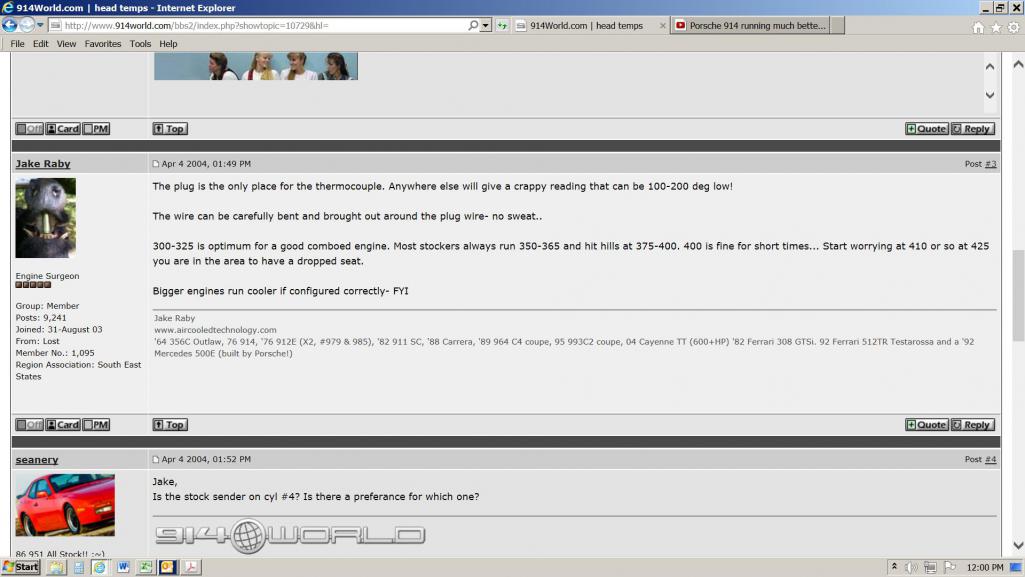
Posted by: djway Feb 8 2017, 10:11 PM
When I set up my L jet that had been horribly messed up, after warming up the car I jumped on the freeway and ran at 3000rpm. WOT was running way to rich as was AF ratio at 3k. I would shoot down an offramp, tighten the spring and jump back on the freeway. When I finally got it to run at 15.8 at 3k the WOT was right where it should be. Popped the lid back on the AFM and the only problem I have had since is that when really cold I need to crack the throttle just a bit to start. The motor is old and a bit low on compression but cruises like a dream.
Posted by: malcolm2 Feb 9 2017, 10:15 AM
When I set up my L jet that had been horribly messed up, after warming up the car I jumped on the freeway and ran at 3000rpm. WOT was running way to rich as was AF ratio at 3k. I would shoot down an offramp, tighten the spring and jump back on the freeway. When I finally got it to run at 15.8 at 3k the WOT was right where it should be. Popped the lid back on the AFM and the only problem I have had since is that when really cold I need to crack the throttle just a bit to start. The motor is old and a bit low on compression but cruises like a dream.
When you say WOT was "where it should be", do you mean per Chris's statement (12.8 -12.5?)?
And when you say "run at 15.8 at 3k" are you cruising, downhill or decal-ing, also as Chris suggests?
one of Chris Foley's posts
in A:F ratio, you want to see:
13.5-12.9 on the gauge while accelerating or climbing,
12.8-12.5 at WOT,
and 16-17 while cruising, going downhill or decelerating.
I need to read up on all the adjustments, cause when I move the spring every level moves.
I have not moved the spring this week, but I did back out the CO screw. It is about centered (4.5 turns from the btm) now, with the @20 teeth CCW of the spring(last Saturday) I get:
12.5 at @1K idle,
12.5 at 3200 cruise at 70mph
10.5 at WOT.... after about 15 seconds the needle heads back up a bit.
Question for all.... How can Cruising and Decelling be the same? I have a steep hill in my hood. I coast down (leave the car in 3rd, foot off the gas) and the AF goes to 18.
Posted by: djway Feb 9 2017, 08:45 PM
You are running WAY to rich. At full throttle only guys with turbos or huge motors need below a 12 or 13, I don't remember which. There are a ton of post out there, and specs from Porsche. Cruising flat land the mixture should be at what is called Stoic which is short for stoichiometry which is used to figure out what is the best combination of compounds to get the max use out of everything involved. Cruising downhill you should go above 15.8, completely letting off throttle there should be almost no fuel and you will see very high numbers.
Look up factory specs and set to that at 3000rpm cruising flat land. Stoic for gasoline is 15.8
NO vacuum leaks anywhere
leak test all 5 injectors
check cold start valve for proper function.
check the ohms on the cht sensor. I have different units with different ohm readings and they greatly affect the stoic.
check the sensor and switch for WOT
crank case vent system can be checked if above measure don't help
checking flow rates of each injector if nothing above is helping.
compression more than 20lbs from the highest to lowest cylinder can cause problems
I knew nothing and read every article I could find an all the factory specs etc.
good luck
Posted by: jcd914 Feb 10 2017, 12:55 AM
If your air flow meter has been mucked with already it can be very hard to get set correctly.
I had a 78 VW Bus 2.0L L-jet that the AFM had been messed with.
There is an adjustment for the wiper arm relative to air flow flapper that affects the fuel mixture as well as the spring tension adjustment.
I had to play around quite awhile to get the 2 adjustments working together and get proper fuel mixture at different loads.
It has been too many years to remember my methodology.
I believe I ended up loosening the spring so I would get more flap movement for the same air flow but then moved the wiper to lean it out some to avoid excessively rich mixtures.
Of course what I had to do to mine would have been relative to what the PO had done to it before I got it.
I eventually ended up with a good running bus that ran lean enough to pass smog and get good mileage without cooking the motor.
I was using a 12 volt portable 4 gas exhaust analyzer hooked up everywhere I went for some time.
Good Luck
Jim
Posted by: falcor75 Feb 10 2017, 01:34 AM
Stoic for gasoline is 15.8
Ummm, I dont know what kind of gas you run but usually its 14.7
Posted by: djway Feb 10 2017, 04:07 AM
Stoic for gasoline is 15.8
Ummm, I dont know what kind of gas you run but usually its 14.7
Yep you are correct. It has been a while. So it was 14.7 that I was going for. Thanks for catching that
Posted by: Mark Henry Feb 10 2017, 10:03 AM
If you are running at stoich AFR on an aircooled you're cooking your heads. ![]()
Buy a decent head temp gauge and see for yourself.
Decel AFR is useless info, stop obsessing on it, it doesn't matter because there is no load on the engine. AFR has no bearing on mechanical braking load.
As I said my FI system cuts all fuel at TPS zero on decel (except for idle between 800-1200rpm*) that's no fuel you can't get much leaner than that.
AFR is important under load, WOT, hills, cruise, etc.
WOT 12.5, nickies you can be just over 13:1
Cruise 13 to 13.5 max I aim for just over 13:1, nickies you can run up to 14:1
Hills basicly the same as WOT, maybe a hair more.
* IIRC I'd have to check my program to see the range and my car is in storage, but 800-1200 is close enough.
Posted by: malcolm2 Feb 10 2017, 11:41 AM
On WOT are you documenting at bottom value? I tend to dip to 11, then rise back to 13. I can say that this is the 1st time I ever ran the car at WOT. Kinda fun but it is acellerating so fast i get skeerd.
I ran the CO screw out 1 more rotation last night. That got me from cruising at 12.5 to 12.8.
That screw is about 4.5 turns out now.
Posted by: Porschef Feb 10 2017, 11:56 AM
Clark, are you referring to the screw on the AFM itself? Thats the only one I know of and is only an air bypass for idle. I found my car idled like crap if it was too rich, opening the screw helped.
Posted by: Porschef Feb 10 2017, 11:58 AM
Mark, i get the nickies can deal with a leaner mixture, but what about your head temps, where are they running?
Posted by: Porschef Feb 10 2017, 12:06 PM
IIRC, I'm at 13.2 or so at cruise. The engine seems to like that. Idle im just over 14.
Have you seen the Itinerant Air page? Kinda gives the overall impression that the engine will dictate what it wants, then you have to fine tune from there.
Of course, there shall be no vacuum leaks...
Posted by: malcolm2 Feb 10 2017, 03:21 PM
Clark, are you referring to the screw on the AFM itself? Thats the only one I know of and is only an air bypass for idle. I found my car idled like crap if it was too rich, opening the screw helped.
Yeah, IIRC it is to adjust the CO. But I don't have a CO meter. SOme youtube vids on it too.
Yes it is a bypass within the AFM like on the TB for idle. But this is unmeasured air that is going to increase the AF # as you open it. I believe it is the fine tune portion of the mix.
I really need to open the itinerant how-to document again and read it. I am finally to a point where adjustments and tinkering with the AFM can be measured with my borrowed AFR. And they are moving the needle.
Posted by: malcolm2 Feb 10 2017, 03:26 PM
Of course, there shall be no vacuum leaks...
That is where the AWESOME smoke machine comes in.
I still see some wisps of smoke, but very little. I think I will smoke it a bit in the morning and see if I can knock the remainder out.
The dip stick was one. I added an o-ring but have not re-smoked since that addition.
The hose to the fuel reg was one, but I had some slack in the hose, so I cut it off a bit.
I seemed to see some coming from under the distributor. Is that possible?
These are very lite amounts of smoke, very tuff to tell for sure.
Posted by: Mueller Feb 10 2017, 03:52 PM
I don't like to see much higher than 13:1 in an iron cylinder engine, my nickies engine I can easily run 14:1 no problem.
I can really see the performance degrade as the temps go up in a iron cylinder engine if you run much over 13:1, the nickies equipped engines doesn't suffer from this issue.
Deceleration it doesn't matter...no load.
I have a fuel cut below a certain TPS setting so on decel my meter goes off the scale.
Fuel cut stops popping and/or backfiring on decel on wild cam engines.
plays with cars I'll have to say you are wrong, those number might be fine on a watercooled car, but aircooled always needs to be a bit on the rich side.
Trying for those numbers on an aircooled and you will hole a piston.
Big issue on a performance, wild cam, ITB Type 4 is your vacuum signal will be total shit. This gives the MAP sensor a horrid signal that peeps chase forever, often blaming the FI system.
I run TPS/O2 only program on my T4 2600cc engine, zero issues, runs on par with a modern FI car.
Is there some sort of limp home mode if something with the O2 circuit craps out?
Can you run 2 O2's for redundancy?
Posted by: timothy_nd28 Feb 10 2017, 04:10 PM
If you have smoke coming out from the dizzy, you will need to replace the shafts' O ring.
Posted by: malcolm2 Feb 10 2017, 04:58 PM
If you have smoke coming out from the dizzy, you will need to replace the shafts' O ring.
well damn. That is what I thought might be the issue. If the smoke is coming from there. That damn WASHER is gonna cause problems, and then I have to set the timing again. Who sells them? Guess I better check the parts catalog for a part #.
Tim, You are always telling me bad news. It is usually right.
EDIT>>> I found them. AA has them for $1. it is always a nickel holding up a dollar on this car.
And AA just closed 9 minutes ago.
Posted by: timothy_nd28 Feb 10 2017, 05:23 PM
AA is now closed, so now your thinking RTV? ![]()
You should also check for vacuum leaks at the valve covers while your waiting.
Posted by: Mark Henry Feb 10 2017, 06:19 PM
I don't like to see much higher than 13:1 in an iron cylinder engine, my nickies engine I can easily run 14:1 no problem.
I can really see the performance degrade as the temps go up in a iron cylinder engine if you run much over 13:1, the nickies equipped engines doesn't suffer from this issue.
Deceleration it doesn't matter...no load.
I have a fuel cut below a certain TPS setting so on decel my meter goes off the scale.
Fuel cut stops popping and/or backfiring on decel on wild cam engines.
plays with cars I'll have to say you are wrong, those number might be fine on a watercooled car, but aircooled always needs to be a bit on the rich side.
Trying for those numbers on an aircooled and you will hole a piston.
Big issue on a performance, wild cam, ITB Type 4 is your vacuum signal will be total shit. This gives the MAP sensor a horrid signal that peeps chase forever, often blaming the FI system.
I run TPS/O2 only program on my T4 2600cc engine, zero issues, runs on par with a modern FI car.
Is there some sort of limp home mode if something with the O2 circuit craps out?
Can you run 2 O2's for redundancy?
My system it runs, just take it easy on the go pedal. only thing that can really go wrong is fuse wiring or more likely the sensor.
Posted by: Mark Henry Feb 10 2017, 06:24 PM
Just a FYI, PLX has their O2 WB meters on sale $160 for the gauge type or $190 for the bluetooth.
Bluetooth has no gauge, you use your phone, tab, ipad, etc., but you can also install a gauge for extra coin.
http://www.plxdevices.com/PLX-Wideband-O2-Air-Fuel-Ratio-Sensor-Modules-Gauges-s/125.htm
Posted by: malcolm2 Feb 11 2017, 08:33 AM
Just a FYI, PLX has their O2 WB meters on sale $160 for the gauge type or $190 for the bluetooth.
Bluetooth has no gauge, you use your phone, tab, ipad, etc., but you can also install a gauge for extra coin.
http://www.plxdevices.com/PLX-Wideband-O2-Air-Fuel-Ratio-Sensor-Modules-Gauges-s/125.htm
So with bluetooth you can buy a sensor for each car then use the same "display" phone or tablet? Cool idea. I tried a bluetooth OBD2 set up. But it only works with Samsung stuff not apple.
Posted by: malcolm2 Feb 11 2017, 08:37 AM
AA is now closed, so now your thinking RTV?
You should also check for vacuum leaks at the valve covers while your waiting.
RTV on the ditzy hole? Great idea.
Under the car? Very nice. Gotta remember to look. Charcoal is lit now.
Posted by: Mark Henry Feb 11 2017, 10:16 AM
Just a FYI, PLX has their O2 WB meters on sale $160 for the gauge type or $190 for the bluetooth.
Bluetooth has no gauge, you use your phone, tab, ipad, etc., but you can also install a gauge for extra coin.
http://www.plxdevices.com/PLX-Wideband-O2-Air-Fuel-Ratio-Sensor-Modules-Gauges-s/125.htm
So with bluetooth you can buy a sensor for each car tha use the same "display" phone or tablet? Cool idea. I tried a bluetooth OBD2 set up. But it only works with Samsung stuff not apple.
It says "Smartphone connection - Compatible with Apple and Android"
On the con side so far it only works with their WB and vac/boost gauges.
Posted by: malcolm2 Feb 14 2017, 01:30 PM
On WOT are you documenting at bottom value? I tend to dip to 11, then rise back to 13. I can say that this is the 1st time I ever ran the car at WOT. Kinda fun but it is acellerating so fast i get skeerd.
I ran the CO screw out 1 more rotation last night. That got me from cruising at 12.5 to 12.8.
That screw is about 4.5 turns out now.
Saturday I took a nice long interstate drive. Not too many big hills, but some WOT...
The readings were as above. About 1/2 way home I turned the CO screw one more full CCW turn (OUT).
The readings at 70 mph and 3200 rpm were closer to 12.8
WOT evened out at the same 12.8
Hills also evened at 12.8
NO more adjustments and no driving 'til Monday AM but the readings changed a bit....
It was a cold morning here... 32*F
My readings during the cold drive in and the warmer drive home.
3200 & 70 mph 13.2
WOT 13.2
HILLS 12.8
It rained today, but Wednesday is clear and I'll get more readings. These are really close to Mark Henry's numbers. I am feeling like I am pretty damn close. And I am curious what this might do to my MPG.
Posted by: timothy_nd28 Feb 14 2017, 01:47 PM
Those numbers are better than the 18+ numbers you were getting earlier with a barely running engine. I think you are in the ballpark, but fine tuning is needed.
I also think it's time to re-introduce the AAV to your setup to assist with cold weather starting.
Posted by: malcolm2 Feb 14 2017, 02:37 PM
Those numbers are better than the 18+ numbers you were getting earlier with a barely running engine. I think you are in the ballpark, but fine tuning is needed.
I also think it's time to re-introduce the AAV to your setup to assist with cold weather starting.
Yeah, we thought the meter was messed up... nope, it was just super lean.
I have AAV re-install in the plan. I will probably get to it before the weekend. Time to change the oil too. Maybe my Disty O-Ring will show-up and I can add that to the list.
It has been running rich and ruff for about 2 minutes on these cold morning starts.
Posted by: stugray Feb 14 2017, 02:40 PM
Any leaks coming from the valve cover, dipstick, or dizzy are not considered 'vacuum' leaks.
Those are crankcase vent leaks
They are supposedly important for cars with FI (not sure why other than emissions).
But a car with carbs does not care at all about crankcase venting, except you want to manage it or you will have an engine covered in oil film.
Posted by: timothy_nd28 Feb 14 2017, 03:26 PM
You tell yourself that while trying to start a Ljet with its oil cap off
Posted by: pete000 Feb 14 2017, 04:29 PM
Great read, I am in the exact situation with my 1.8 L-Jet. Even built the smoke machine to verify for no leaks. Worked great. Haven't messed with the flapper box yet, but I have a strong feeling mine is lean. My borrowed Wide band gauge is not too easy to get set up for actual driving. I think welding in a bung is next inline for me. The Innovative tail pipe quick O2 mount seems problematic.
I might just have to invest in the Blue tooth solution you shared the link to, pretty cool !
Posted by: malcolm2 Feb 24 2017, 10:14 AM
No adjustments or significant changes to the readings:
3200 & 70 mph 12.5 - 13.4
WOT 13.2
HILLS 12.8
I have run 2 tanks of fuel thru the car while using and tinkering with the AFR. I have been getting just over 25.3 MPG. no special gas, just 87 oct, e-10.
Looking back at some notes from 2016 with the OLD, now bent, AFM I averaged a bit over 22 mpg driving to work for a week.
So fixing some vacuum leaks, replacing and adjusting the AFM have gotten me a few extra mpg on daily drives, but it is early. Looking forward to burning a tank on the interstate. ![]()
Posted by: timothy_nd28 Feb 24 2017, 10:33 AM
I think your old bent AFM was adjusted abit rich.
Posted by: malcolm2 Feb 24 2017, 01:01 PM
I think your old bent AFM was adjusted abit rich.
I have learned an old Indian trick... "plug reading"
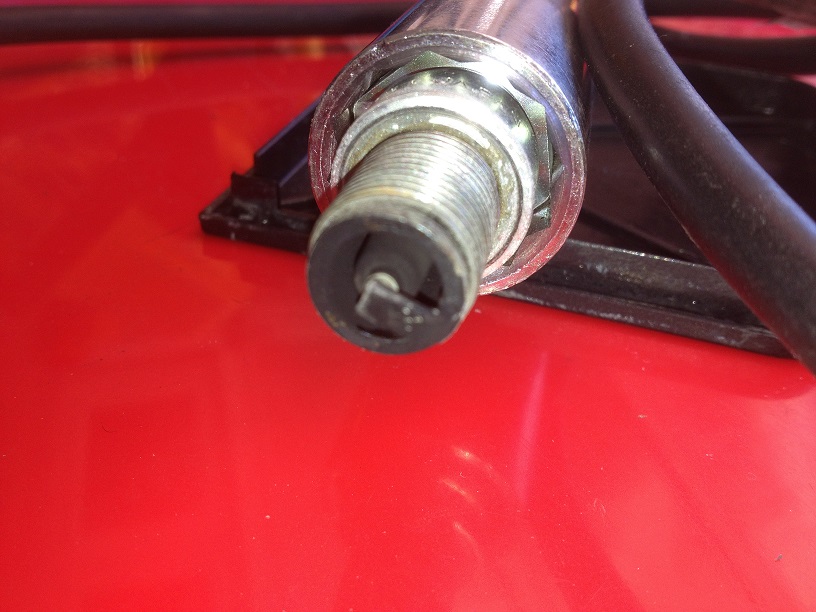
Posted by: malcolm2 Feb 24 2017, 01:04 PM
Mark, I have been studying up on your AFR link from PLX. I am gonna order one this weekend. Going with the gauge model. Looks like you can just buy the blue tooth gizmo later and then use an old I-phone. So that is my plan.
Posted by: veekry9 Feb 24 2017, 03:53 PM
No quick answers,because it's complicated,many factors.
https://www.google.ca/search?q=fuel+mixture+graph&espv=2&biw=1229&bih=598&source=lnms&tbm=isch&sa=X&ved=0ahUKEwiyx8LH0KnSAhUo94MKHWMeAvEQ_AUIBigB
A lean cruise condition at low loads is at one end of the spectrum,highly loaded under acceleration is at the fat,rich end.(1910s)
Change the fuel and the chemistry changes with it,as with methanol/water additives.(1930s)
A turbo application at high boost pressure benefits greatly,stalling detonation and piston holing.(1930s)
Those holes can be had by a lean loaded condition with air cooled engines,as some of you here know.
All of this has been sussed out for 80 years,the military aircraft application the primary impetus.(1930s)
A direct injection fitment to the Type 4 hasn't been done yet to date,and would yield great results with a fine 'smart' mapping.(2017)
A constraint that aircooled engines have is the physical heat dissipation capacity,the mass and size of the fins and the amount of air that passes over them.
Adiabatic cooling systems are a proven upgrade and an easy fit,tho only practical for above freezing climates.(1970s)
Changing out the pistons and heads for a high quench design with piston squirters,a leaner mix can be had,and the application of ceramic coatings will shield them from the heat of combustion.(1970s)
Carburetor jetting is best done on a dyno these days,less time consuming than road testing and plug reading,as was done in the past.(1920s)
Double plugging your six or four has some advantage in flame-front size and expansion,so a leaner burn can be had.
Ultimately,the engine's ability to dissipate conducted heat is the limiting factor,so,the simplest course is to cool the engine and intake charge.
[url]https://www.google.ca/search?q=direct+injection+flame+front+simulation&espv=2&biw=1229&bih=598&source=lnms&tbm=isch&sa=X&ved=0ahUKEwjPmJ7T2anSAhWG4IMKHW13AsEQ_AUIBigBue
![]()
![]()
Great advantage.Be the first.
Be cool.
/
Posted by: pete000 Mar 5 2017, 12:56 AM
I picked up one of the PLX Blue Tooth AFR systems and it works really well. Display is easy to read although I do wish it had a record feature though. I had a bung welded in my Bursh muffler at the main collector as to read all four cylinders.
Did a small drive today for an hour on some hills here and was getting pretty consistent readings in the 15s cruising fairly flat roads, under WOT saw it dip into the high 14s. Climbing with a fairly heavy pedal it would also dip into the 14s.
Coasting down hill throttle closed it goes to full lean condition as expected.
After following this thread, sounds like I am a tad lean? Should I be in the 13s under WOT and 14s for cruising vs 14s and 15s I am seeing now? I do not have a CHT gauge, so not too sure what the heads temps are.
Might have to crack the lid off the flapper box and ritchen it up a few teeth. I have read a lot of adjusting the Bosh AFR over on the SAMBA.
My car is also a 74 1.8 L-Jet
https://youtu.be/owYGugwTguE
Attached thumbnail(s)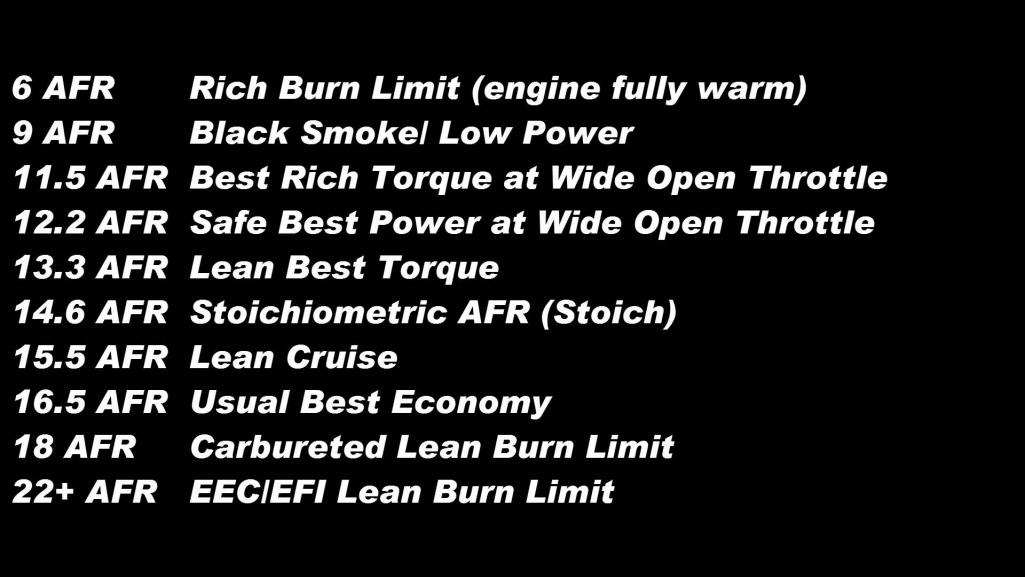
Posted by: Mark Henry Mar 5 2017, 07:55 AM
Yes 15:1 cruise is too lean for an aircooled 14:1 would be the max and even then I'd want a good headtemp gauge to be sure they're not getting too hot.
That chart might be OK for a watercooled, but not aircooled. WC big advantage is they can control head temps way better than air cooled.
Aircooled has a much narrower burn AFR range.
This would be my aircooled chart;
About 11:1 is the max for rich burn
WOT power between 11.5 and 13
Max performance WOT 12.3 to 13 maximum
Lean burn no higher than 13.5-13.7, nickies can run 14:1-14.3
The exception to the above is decel, AFR on decell is of no concern, of course it's a high reading, you just took away all the fuel, but no load so it's not producing heat.
You can run richer than 11:1 without really hurting the engine, but your power and tune goes to poop.
Anything over stoich you better have a damn good head temp gauge to monitor your temps, you are getting into dangerous territory.
As you head temps go over 350f you will start to lose power as a heat soak condition starts to set in.
Running 17-18:1 and you will have a hole in a piston PDQ.
Basic rule on heat temp and heat soak is you can go over 350f on a long hill, as long as the temps recover on the downside. Once the temps are not recovering on the downside of the hill you have a heat soak issue. Even a cheap VDO gauge you can easily see this heat soak/no recovery condition.
Head temps consistent 325f is about perfect, 350F is OK, but I don't want to see much more for long periods of time.
On my LN nickies I don't see much over 300F unless I'm really hammering it on a hot day.
Posted by: McMark Mar 5 2017, 09:46 AM
I agree with and support everything Mark Henry has been saying. ![]()
Posted by: malcolm2 Mar 5 2017, 08:01 PM
My PLX rig showed up Friday. Looking forward to getting it in the car this week. Turns out they sell on Amazon too. $169 was a little better price.
Posted by: pete000 Mar 6 2017, 11:20 PM
My PLX rig showed up Friday. Looking forward to getting it in the car this week. Turns out they sell on Amazon too. $169 was a little better price.
You got a great price, mine was 180.00 direct from PLX via Ebay...
I have a second AFM flapper box and will be trying it to compare to the rebuilt unit I am currently running. Will start turning the wheel to see if I can get this thing closer to Mark's recommendation numbers..
Posted by: timothy_nd28 Mar 7 2017, 11:22 AM
Be careful. The air flow meter has a wound up clock spring that will take off on you when you loosen the retaining screw and if you don't keep constant pressure on it. There is a air flow meter bible that you should read and re-read 3-4 times before making any adjustments.
Posted by: malcolm2 Mar 7 2017, 02:16 PM
Be careful. The air flow meter has a wound up clock spring that will take off on you when you loosen the retaining screw and if you don't keep constant pressure on it. There is a air flow meter bible that you should read and re-read 3-4 times before making any adjustments.
http://www.itinerant-air-cooled.com/viewtopic.php?f=50&t=7761
Posted by: pete000 Mar 7 2017, 10:59 PM
Sounds like these early FI cars are set from the factory lean compared to today's fuel.
I have a couple Flapper boxes to try out to compare. I think that they will require to be turned to ritchen the mixture.
Here is my O2 sensor and PLX installation.
Video on how to richen the AFM.
https://www.youtube.com/watch?v=yQukm7lNux4
Attached image(s)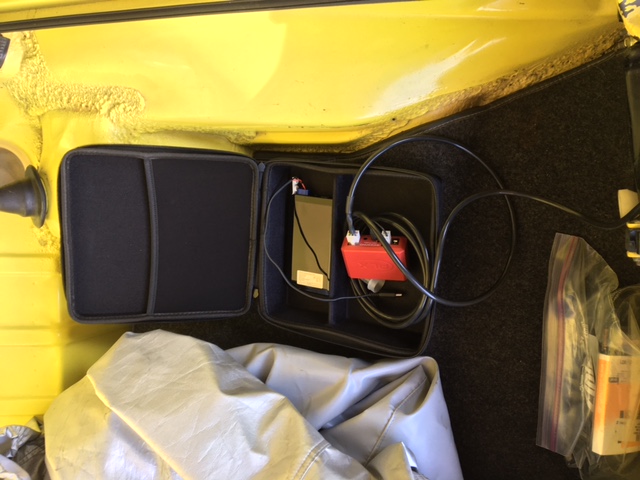
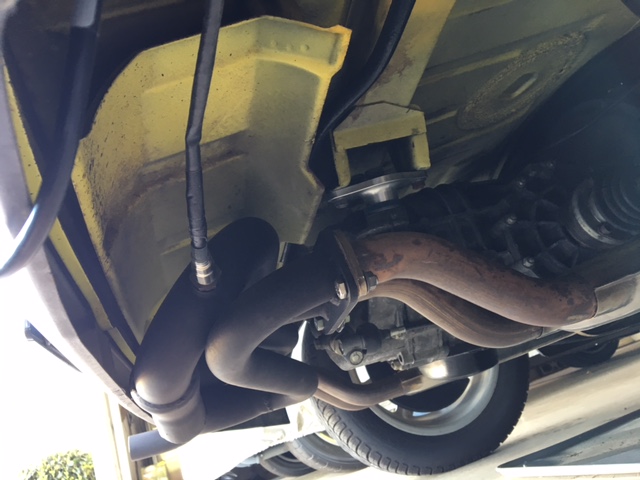
Posted by: malcolm2 Mar 10 2017, 02:30 PM
I do like welding stuff.... but man you can screw things up in a hurry.
Here is the result of my BUNG HOLE ![]()
![]() welding.
welding.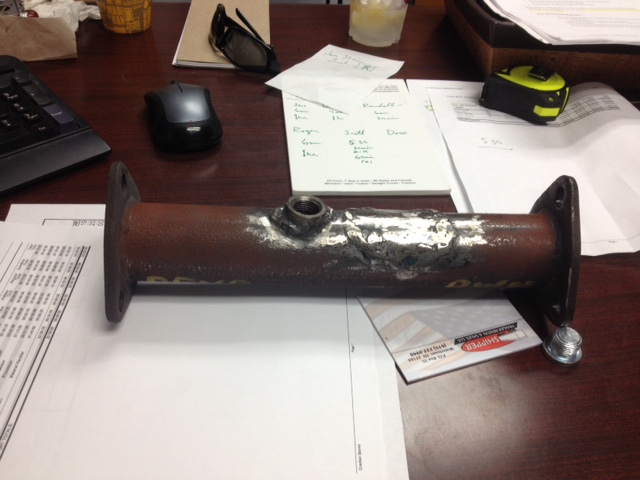
It took 3 bungs and some patching of the areas I screwed up, but I am not too proud to show the world.
Point of interest here. I did not really screw up on the welding of the bung to the pipe. I saw a YouTuber that installed the plug that is supplied with the bung. He then welded. His thought was to keep spatter off of the inner threads.... makes sense to me.
Well the bung gets hot and ends up galling up the plug so you can't get it out.
I ended up covering the hole with a small bolt dropped in the bung and a large washer.
Repairs are complete, I'll add some Hi Temp paint to hide my grinding work and start working on where the wiring goes this weekend. Good garage day, it is supposed to snow in Nashville. ![]()
Posted by: Mark Henry Mar 10 2017, 03:04 PM
Was your wire feed sticking?
You likely need a new whip liner, but you could also try to make you whip as straight as possible.
Posted by: malcolm2 Mar 10 2017, 03:10 PM
Was your wire feed sticking?
You likely need a new whip liner, but you could also try to make you whip as straight as possible.
I had the heat set high (3) to begin with and it ran nicely. But if I did not keep moving consistently... I burned some holes in the thin pipe. Turned down a notch and I got no holes, but did get some spatter and wire sticking on the work piece.
Did not think of keeping the whip straight. I will pay attention to that next time.
Posted by: malcolm2 Mar 23 2017, 09:55 AM
PLX is now installed. The guage is temp'd in with a shoe box and a clip.
Reading was 13.8 to 14.5 last night. I closed my CO screw one full turn. Cruising and hills reading is now 12.7 to 13.5.
Heading to NC at lunch. 5 hour drive. I will enjoy monitoring it. 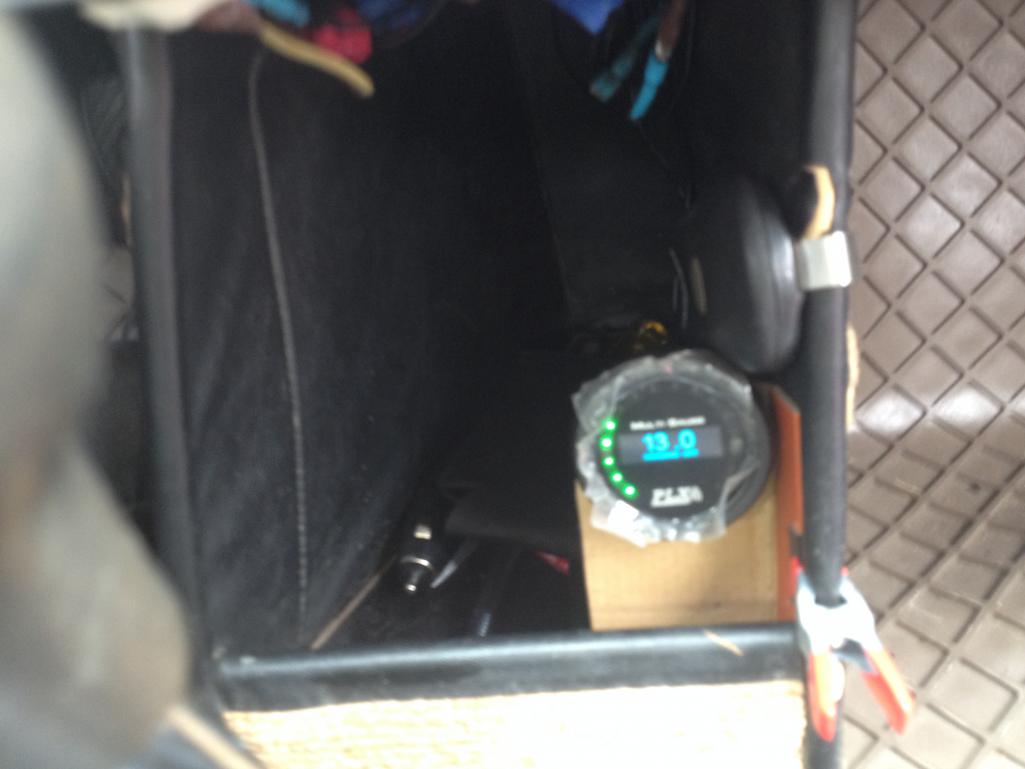
Posted by: pete000 Mar 23 2017, 06:57 PM
I have been playing around a bit with my AFM. I have a couple of them so I figured one would be a good test mule. I read about a mod the VW Bus guys were doing. The later Bosch AFMs had a jumper wire installed to help the conductivity. This is an easy upgrade to do by soldering a jumper wire from the wiper arm to the large connector bar (See blue wire). I also cleaned all the contacts while I had it apart. I did a before and after OHM test and the numbers seemed to smooth out a bit after the mod and tune up. There are You Tube videos on all of this.
Now to try to get some time to get out and test the AFR results. ![]()
Attached thumbnail(s)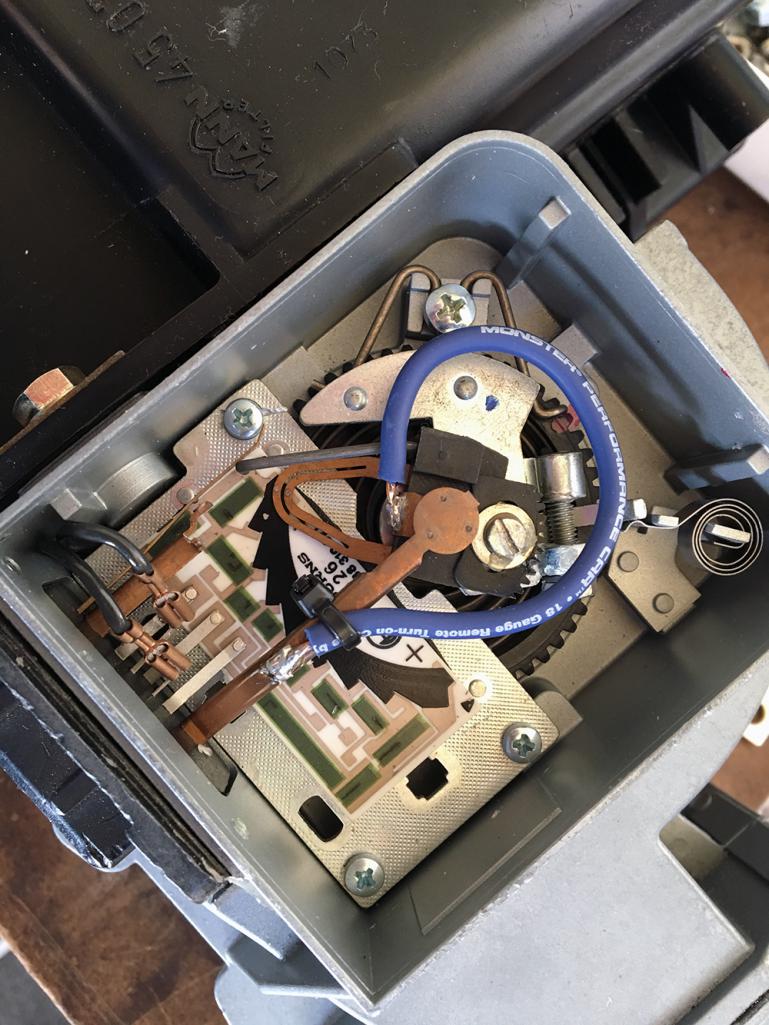
Attached image(s)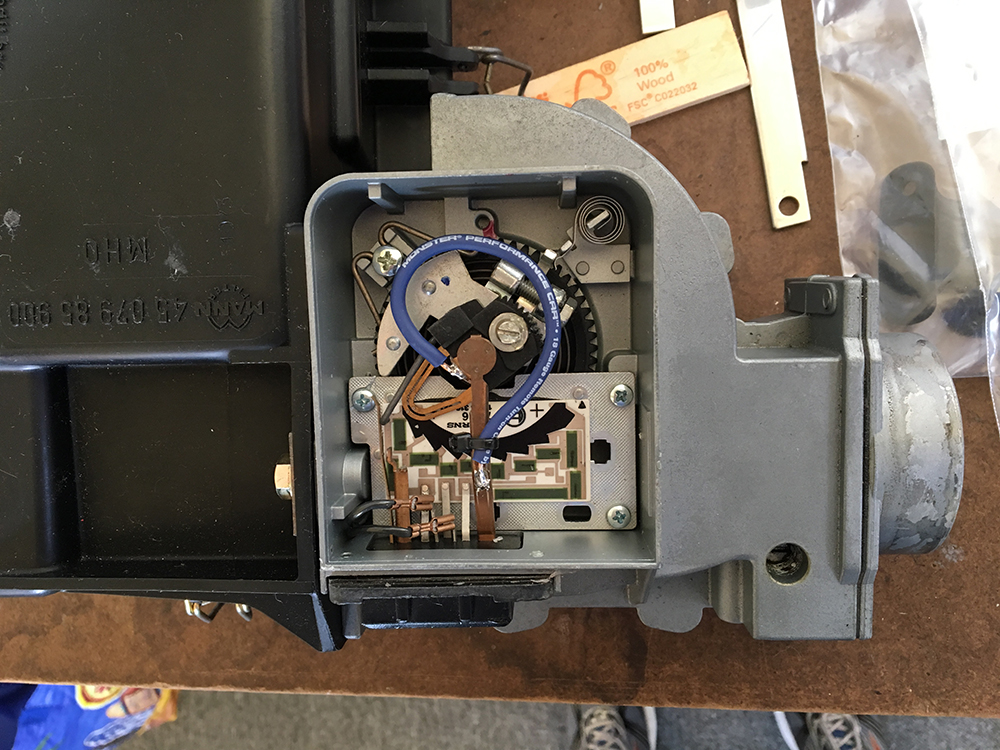
Posted by: malcolm2 Mar 24 2017, 06:22 AM
My AFM has that jumper. Did not know it was an add on.
5 hours of interstate driving. Several big hills.
Cruising at 3400 between 70 and 80 the a/f guage was between 12.2 and 12.7. CHT went to 375 on the hills but was 325 to 350 the rest of the time.
I'll fill up with gas today. It seemed to get good mileage. I think 25 mpg was the last i remember with the now bent AFM. 320 miles and still above 1/4 tank.
Posted by: malcolm2 Mar 24 2017, 06:23 AM
5 hours of interstate driving. Several big hills.
Double post
Posted by: Porschef Mar 24 2017, 07:50 AM
Hey Clark,
PM sent
Joe
Posted by: timothy_nd28 Mar 24 2017, 10:15 AM
Sounds like you are around 26 mpg. I think with this system correctly dialed in, you may get closer to 30 mpg. I'm curious what the spark plugs look like after this trip of yours.
Posted by: timothy_nd28 Mar 24 2017, 10:48 AM
I take back what I said. Maybe you are already getting 30mpg, driving through the Appalachian mountain will skew any MPG readings.
Posted by: pete000 Mar 24 2017, 04:49 PM
Tested out my AFM mods and seemed to work well. Was a bit lean but a few teeth adjustment on the flapper wheel and I was able to get it to settle around 12.9 - 13.5 cruising and dips to the low 12's under load.
Re adjusted the timing and will try it again tomorrow. So far seems to be much happier.
Posted by: malcolm2 Mar 27 2017, 03:16 PM
I made it home.... 800 + mile weekend trip. I don't think I will go that far again until I get some new padding for my seats. ![]()
![]()
As far as the A/F goes... I filled up with pure gas, 89 oct I believe it was. So the 1st 330 miles started with maybe 25% 87 oct e10 + 75% 89 oct pure.
MPG (best numbers I have ever recorded)
tank 1: all interstate: 337.5 / 11.25= 30 mpg
tank 2: 100 miles of city: 314.2 /9.99 = 31.4 mpg
tank 3: 151 miles of interstate: xxx/xx = still on 1/2
I-40 from Nashville to Asheville has quite a few hills, some 4 to 5 miles long.
The car ran very well. I visually logged @ 12.7 a/f cruising on flat ground at about 3400 rpm. Up the hills still at 3400 rpm, CHT reached 380-ish and the a/f evened out at 12.5. Oil temps were steady at 210.
My total a/f interstate range for the most part was 12.3 to 13. Once thru the mountains with only about 20 miles to go, I noticed there were times it was running richer. I saw some 12.0's even 11.8 for brief times.
City driving on Friday, it would idle at 14.6 then stop-to-stop up to 4th gear and 3000+ rpm I say I saw 12.5 - 13.
I did not see the rich numbers yesterday. the range was about like the City driving 12.3 -12.8 all day on 87 oct e10 fuel. 3400 to 3800 rpm 70 - 80 mph.
Unless someone thinks I am out of whack, I think I may not tweek any further.
I will also edit and add a spark plug photo for Tim.... ![]()
Posted by: malcolm2 Mar 27 2017, 04:33 PM
Ok what do you think? Maybe 1000 miles with this new AFM and it's set up. 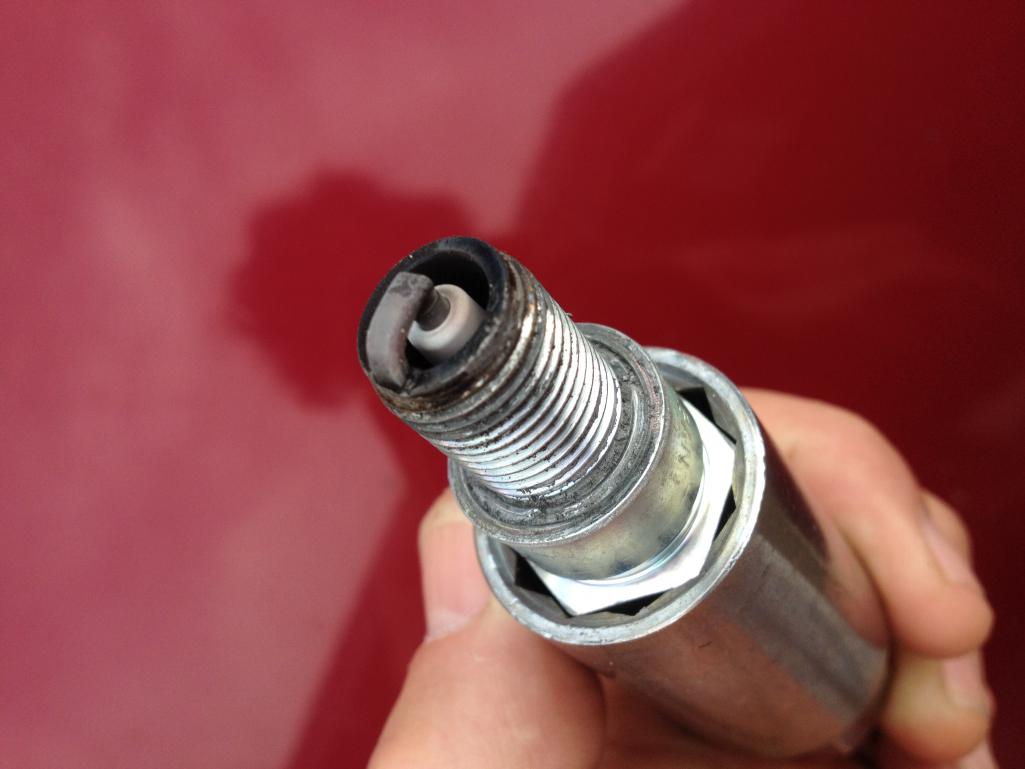
Posted by: timothy_nd28 Mar 27 2017, 05:10 PM
I got nothing. My work with you is done.
Posted by: Mark Henry Mar 27 2017, 05:17 PM
I'd say that plug is a tad hot, what number is it? Brand?
What are you running for total advance?
I'm looking for beige or tan colour on the insulator, your insulator is too white. Or is it just the pic?
Edit: could be my one monitor, on the other one it looks about right. As long as the insulator doesn't have a gloss finish appearance it should be correct.
I run two monitors but one is better than the other.
Posted by: malcolm2 Mar 27 2017, 07:11 PM
I'd say that plug is a tad hot, what number is it? Brand?
What are you running for total advance?
I'm looking for beige or tan colour on the insulator, your insulator is too white. Or is it just the pic?
Edit: could be my one monitor, on the other one it looks about right. As long as the insulator doesn't have a gloss finish appearance it should be correct.
I run two monitors but one is better than the other.
They are NGK BR5ES. It was cylinder #2. Have not checked the timing in a while. I guess I should.
I thought it was pretty white too. Don't remember seeing one that white. I figured that was a good thing. It was not shiney.
Thanks
Posted by: Olympic 1.7 Mar 28 2017, 07:55 AM
Spark plugs are an easy change, you could try NGK 6 in there, its one step colder.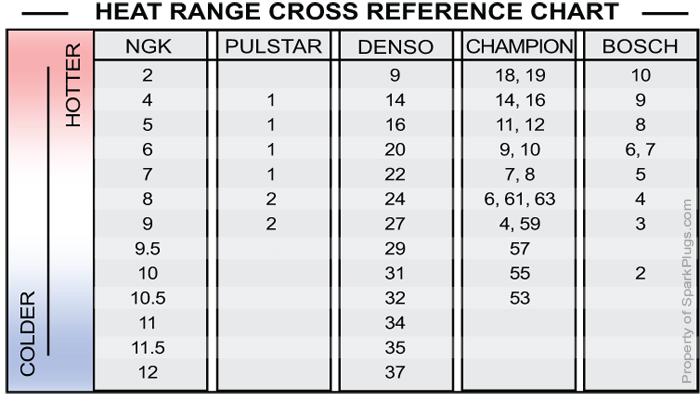
Posted by: 72hardtop Apr 24 2017, 05:38 AM
This is a great graph for air cooled engines:
https://www.thesamba.com/vw/gallery/pix/1463782.jpg
14.7-15 or so is the 'No go zone' danger. Shoot for ~12.5 - 13.0 WOT/Accelerating and while at cruise (part throttle cond) 16-17 AFR
Use an LM-2 wide band
16-17 AFR at cruise (part throttle cond) is cooler running (EGT's/CHT's) than 13:0-13:5 same scenario.
Posted by: 72hardtop Apr 24 2017, 05:49 AM
Yes 15:1 cruise is too lean for an aircooled 14:1 would be the max and even then I'd want a good headtemp gauge to be sure they're not getting too hot.
That chart might be OK for a watercooled, but not aircooled. WC big advantage is they can control head temps way better than air cooled.
Aircooled has a much narrower burn AFR range.
This would be my aircooled chart;
About 11:1 is the max for rich burn
WOT power between 11.5 and 13
Max performance WOT 12.3 to 13 maximum
Lean burn no higher than 13.5-13.7, nickies can run 14:1-14.3
The exception to the above is decel, AFR on decell is of no concern, of course it's a high reading, you just took away all the fuel, but no load so it's not producing heat.
You can run richer than 11:1 without really hurting the engine, but your power and tune goes to poop.
Anything over stoich you better have a damn good head temp gauge to monitor your temps, you are getting into dangerous territory.
As you head temps go over 350f you will start to lose power as a heat soak condition starts to set in.
Running 17-18:1 and you will have a hole in a piston PDQ.
Basic rule on heat temp and heat soak is you can go over 350f on a long hill, as long as the temps recover on the downside. Once the temps are not recovering on the downside of the hill you have a heat soak issue. Even a cheap VDO gauge you can easily see this heat soak/no recovery condition.
Head temps consistent 325f is about perfect, 350F is OK, but I don't want to see much more for long periods of time.
On my LN nickies I don't see much over 300F unless I'm really hammering it on a hot day.
Well in a 914 one may not see much over 350F or so if everything is dialed in. But temps over 350F are not for much concern. It's when you go over 400+F then start worrying.
As for AFR's once you start pushing beyond 15:1 the EGT's go down. Why? Simple you are closing the burn (fuel off). The below chart shows the relations between EGT, CHT, HP and ICP. Peak EGT is ~14.7-15:1
During 'cruise' get into the 16-17AFR for cooler running. Part throttle cruise is NOT a load condition. Ones foot dictates load. If you're running around during cruise at 13:0 - 13:5 you are wasting fuel and running hotter EGT's and CHT's than you would be if you were running 16-17AFR at cruise (part throttle).
https://www.thesamba.com/vw/gallery/pix/1463782.jpg
Posted by: Vacca Rabite Apr 27 2017, 09:13 AM
350 degrees is not normal, atleast I hope not. Remove the thermostat cable and repeat the test.
350 going up hill at 70 sounds pretty good to me, especially if the CHT is reading cyl 3 and you are in 5th gear.
My car always used to be approaching 400 on long highway hills in 5th. It would be pulling like a champ, but getting hot. I learned to downshift to 4th at the base and keep that air moving. That said I never had valves stretching on me. Now that I'm in EFI and have a wideband I'm looking forward to see if my engine stays on the hot side or if its now going to run a bit cooler. But I'd love to see 350 at 70MPH running up some of the long ass hills here in PA.
Zach
Posted by: malcolm2 Apr 28 2017, 06:29 AM
I'd love to see 350 at 70MPH running up some of the long ass hills here in PA.
Zach
on my daily drive I have a long, low hill that I have been comparing each day.
On my last trip to SC there is a mountain to climb. It seems like it is 5 miles long and very steep. My VDO CHT under #3 needle moves to what I would call 375 in 5th gear on that "hill".
I filled up with 90 octane pure gas yesterday. This morning, on the "hill" maybe 75 mph the A/F was 12.2-ish and cht was dead on 350.
So the A/F seems a bit rich, but still in range. Earlier in the week with 93 oct, E-10 it was reading 12.7 on my daily hill.
Posted by: jpapatrout May 6 2017, 04:24 PM
I just saw an ad for an AFR from Innovate that monitors 2 sensors. They say left and right banks on a V8 engine may run different numbers. Does anyone have experience/opinions on this? Could this be helpful?
Posted by: 72hardtop Oct 29 2018, 02:19 AM
Was it allowed to idle prior to pulling the plug/ It matters even the slightest. Also with today's ethanol blended fuel E10+ it takes a few thousand miles of seasoning the plugs before you can use them as a gauge for AFR.
Load = WOT
Part throttle is NOT load
Cruise = part throttle condition
An AFR of 16-17 at cruise (part throttle cond) is COOLER running than at an AFR of 13:0 - 13:5
With respect to jetting....Get above (14-15AFR range) when on the progression and below (14-15AFR when on the main jets. 90% of ones driving is on the progression circuit (idle jets).
The following chart shows this....
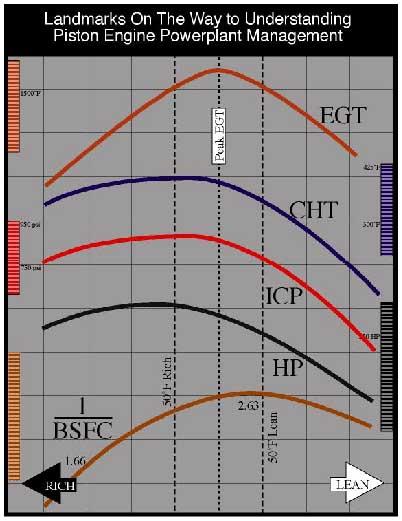
Posted by: 72hardtop Oct 29 2018, 02:29 AM
Incorrect.
Under load? Yes.
At cruise? No
Cruise = part throttle condition. One is not at WOT/load under that scenario.
Nothing wrong with 16-17 AFR with a cracked throttle. Throttle position dictates load.
Posted by: Chi-town Oct 29 2018, 10:36 AM
There is no "short answer" for this question.
There are some basic references for non forced induction though.
WOT = 12.7-13.2 under heavy load
Cruise = 13.7-14.7 under light load
Idle = Hot-13.0-15.0 / Cold- 11.5-12.5
Now keep in mind all of these are dependent on timing.
You need to know where your base timing is set, what your advance curve looks like and your peak advance.
This is where those old SUN distributor machines come into play.
You need to measure the weights and spring tensions, the diaphragm movement per inch of vacuum in the actuator.
Even off the shelf reman distributors often have the wrong curve as they mix and match weights and springs.
Now that you've got your distributor curved correctly, timing set, and your wideband O2 installed Now you can tune your carbs or check your F.I. to make sure it's operating correctly.
Reading plugs is a good back up to the wideband and will tell you if you're too aggressive or not aggressive enough with timing.
Here's some good reading on that:
https://honda-tech.com/forums/forced-induction-16/%2A%2A%2A-basics-reading-spark-plug%2A%2A%2A-3063102/
Remeber always make minor adjustments and don't get crazy aggressive and your engine will last a long time.
Posted by: 72hardtop Nov 1 2018, 12:04 AM
There is no "short answer" for this question.
There are some basic references for non forced induction though.
WOT = 12.7-13.2 under heavy load
Cruise = 13.7-14.7 under light load
Idle = Hot-13.0-15.0 / Cold- 11.5-12.5
Now keep in mind all of these are dependent on timing.
You need to know where your base timing is set, what your advance curve looks like and your peak advance.
This is where those old SUN distributor machines come into play.
You need to measure the weights and spring tensions, the diaphragm movement per inch of vacuum in the actuator.
Even off the shelf reman distributors often have the wrong curve as they mix and match weights and springs.
Now that you've got your distributor curved correctly, timing set, and your wideband O2 installed Now you can tune your carbs or check your F.I. to make sure it's operating correctly.
Reading plugs is a good back up to the wideband and will tell you if you're too aggressive or not aggressive enough with timing.
Here's some good reading on that:
https://honda-tech.com/forums/forced-induction-16/%2A%2A%2A-basics-reading-spark-plug%2A%2A%2A-3063102/
Remeber always make minor adjustments and don't get crazy aggressive and your engine will last a long time.
WOT = 12.7-13.2 under heavy load
Cruise = 15.5-17:0 under light load (better MPG's)
14:0 - 15:0 is where the highest EGT's & CHT's will be. Get above that zone when on the progression circuit and below it when on the mains (WOT).
Idle isn't where we/one drives so it's out of the pic.
Reading plugs takes time. With new plugs you need a couple thousand miles for them to get seasoned.
Posted by: 914Toy Nov 1 2018, 09:13 AM
I just saw an ad for an AFR from Innovate that monitors 2 sensors. They say left and right banks on a V8 engine may run different numbers. Does anyone have experience/opinions on this? Could this be helpful?
I have one of these with my 911 engine headers. Info is very helpful tuning carbs. Do not cut the harness to fit your application.
Powered by Invision Power Board (http://www.invisionboard.com)
© Invision Power Services (http://www.invisionpower.com)
